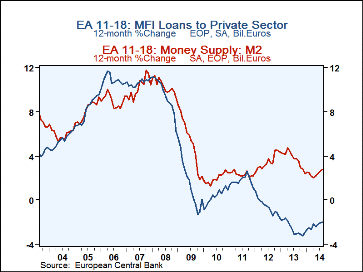 Global| Sep 25 2014
Global| Sep 25 2014Little Evidence of ECB Stimulus Taking Hold in August
Summary
On the plus side of things, both EMU credit and money supply have begun to bend their growth rates higher. However, for money supply, growth is still weak. It remains below its feeble 2013 cycle peak. For credit, the growth rate has [...]
 On the plus side of things, both EMU credit and money supply have begun to bend their growth rates higher. However, for money supply, growth is still weak. It remains below its feeble 2013 cycle peak. For credit, the growth rate has turned up early 2014 although that means that credit growth to the private sector is falling at a slower pace. This is not evidence of a very effective program from the European Central Bank.
On the plus side of things, both EMU credit and money supply have begun to bend their growth rates higher. However, for money supply, growth is still weak. It remains below its feeble 2013 cycle peak. For credit, the growth rate has turned up early 2014 although that means that credit growth to the private sector is falling at a slower pace. This is not evidence of a very effective program from the European Central Bank.
The ECB has a program to try to stimulate private sector credit. Under this program, it will advance funds to banks on the condition that they increase loans to the public. On the face of the statistics, this policy is not very successful.
Looking at the table and the sequential growth rates, we see private sector credit even over shorter horizons is not showing much tendency to do any better than it is over 12 months. It's growing at a 2% annual rate over 12-months. That's better than its two-year growth rate of -2.5%, but over three months, private sector credit is shrinking at a slightly stepped-up -2.2% pace. Money supply, however, is accelerating in the monetary union. The 12-month growth rate at 2.8% moves up to 3.8% over six months and 5.2% over three months. At least money supply is on the move in the right direction. However, from late 2011 until recently, there has been a clear money/credit disconnect.
Global money supply trends Money supply growth in the U.S. edged down slightly from 12 months. Its 12-month growth rate is 6.5% that steps down to 5.8% over six months and to 5.5% over three months. The U.K. shows a somewhat erratic pattern of money growth, shrinking by 0.8% over 12 months, shrinking faster by 3.7% at an annual rate over six months and then growing 2.8% at an annual rate over three months. Japan's money supply growth is quite steady, ranging between 2% to 3% over 12 months, six months and three months.
Looking at the bottom of the table and at real (inflation-adjusted) money supply and credit growth, the picture for the EMU does not improve. Money supply growth is still accelerating slightly from 2.4% over 12 months to 4.3% over three months. But private sector credit is shrinking at a 2.3% pace over 12 months and at a 3% pace over three months. Things are getting worse on the credit front, once we adjust for inflation.
Looking at real money balances, in the rest of the world we see U.S. money supply comes out looking much flatter at a 4.7% annual rate of growth over 12 months and 4.9% over three months. The U.K. still has negative growth rates over 12 months and six months but its three-month growth rate only picks up to 0.3%. Japan's money supply growth shows more acceleration when inflation-adjusted with year-over-year M2 plus CDs growth at -0.3%, stepping down at -3.2% over six months and up to 1.7% over three months. There's room in the Japanese figures to call Japanese stimulus more successful; part of that is that the inflation rate is moving up and in positive territory in Japan.
On balance, global money supply growth rates remain subdued. The U.S. is running the consistently highest rates of nominal money growth. The EMU is showing some pickup in growth. However, in the monetary union where the central bank has set its sights on stimulating credit growth, there is precious little evidence that the policy is successful. Recent activity data from Europe have been weak and Europe continues to see geopolitical stress on its doorstep. Mario Draghi commented today that he is still confident that growth is going to pick up in the second half of the year despite disappointment in the first half. Hope, at least, springs eternal. But it would be nice to see some EMU credit growth too.

Robert Brusca
AuthorMore in Author Profile »Robert A. Brusca is Chief Economist of Fact and Opinion Economics, a consulting firm he founded in Manhattan. He has been an economist on Wall Street for over 25 years. He has visited central banking and large institutional clients in over 30 countries in his career as an economist. Mr. Brusca was a Divisional Research Chief at the Federal Reserve Bank of NY (Chief of the International Financial markets Division), a Fed Watcher at Irving Trust and Chief Economist at Nikko Securities International. He is widely quoted and appears in various media. Mr. Brusca holds an MA and Ph.D. in economics from Michigan State University and a BA in Economics from the University of Michigan. His research pursues his strong interests in non aligned policy economics as well as international economics. FAO Economics’ research targets investors to assist them in making better investment decisions in stocks, bonds and in a variety of international assets. The company does not manage money and has no conflicts in giving economic advice.






